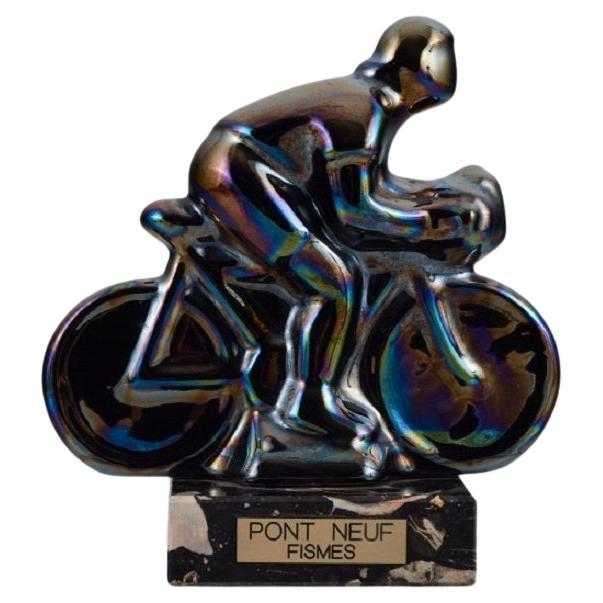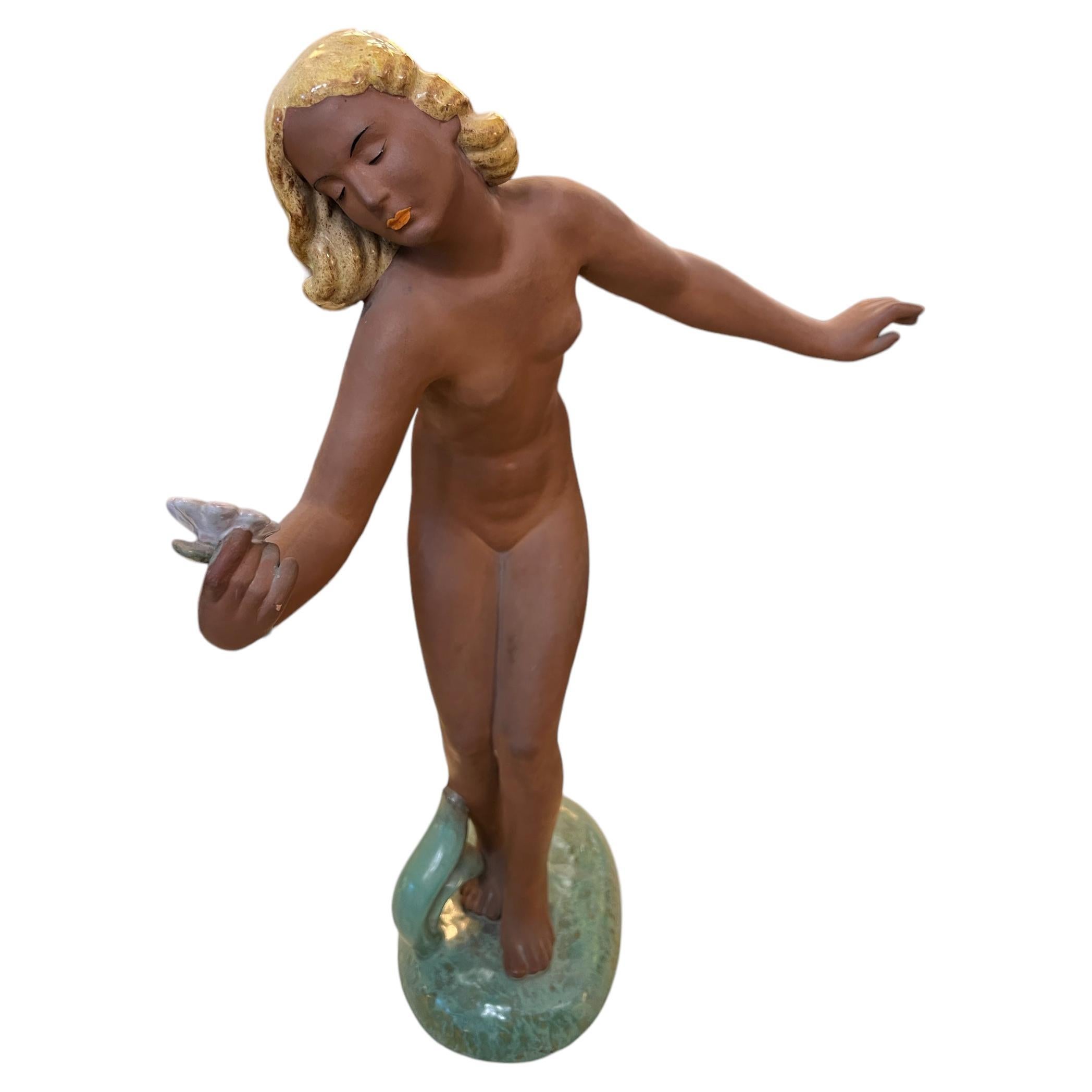Items Similar to A Ceramic Chicken in a Modernist Art Deco Abstracted Form
Want more images or videos?
Request additional images or videos from the seller
1 of 10
A Ceramic Chicken in a Modernist Art Deco Abstracted Form
About the Item
A ceramic chicken in a modernist Art Deco form. Possibly by Raymor.
- Dimensions:Height: 10.5 in (26.67 cm)Width: 10 in (25.4 cm)Depth: 2.5 in (6.35 cm)
- Materials and Techniques:
- Place of Origin:
- Period:
- Date of Manufacture:1940s
- Condition:Very good original condition. One old chip to the bottom.
- Seller Location:NYC, NY
- Reference Number:
About the Seller
4.3
Vetted Seller
These experienced sellers undergo a comprehensive evaluation by our team of in-house experts.
Established in 2001
1stDibs seller since 2005
112 sales on 1stDibs
Typical response time: Several days
- ShippingRetrieving quote...Ships From: NYC, NY
- Return PolicyThis item cannot be returned.
More From This SellerView All
- Ceramic Tray by Garouste & BonettiBy Elizabeth Garouste and Mattia BonettiLocated in NYC, NYA lavender and gold ceramic tray by artists Elizabeth Garouste and Mattia Bonetti. The tray is part of the Boogie-Woogie collection which includes other ceramic table accessories. Th...Category
1990s French Organic Modern Ceramics
MaterialsCeramic
- Danish Studio Ceramic Vase, Style of Axel SaltoBy Axel SaltoLocated in NYC, NYA small studio ceramic piece of bulbous organic form with richly layered glaze, in the style of Danish ceramic artist Axel Salto. Unmarked, Scandinavian and mid-20th century.Category
Vintage 1940s Danish Scandinavian Modern Ceramics
MaterialsCeramic
- Art Nouveau Bronze Letter OpenerLocated in NYC, NYAn Art Nouveau bronze letter opener with beautiful carvings.Category
Early 20th Century Portuguese Art Nouveau Desk Accessories
MaterialsBronze
- Box with a Shell Lid in Style of Alexandre NollBy Alexandre NollLocated in NYC, NYA beautiful wood box with a small compartment inside and a shell lid in the manner of Alexandre Noll.Category
Vintage 1940s French Minimalist Decorative Boxes
MaterialsShell, Walnut
- Lucite Clock Sculpture in the Manner of ArmanBy ArmanLocated in NYC, NYA Lucite clock sculpture displaying a clock face and pieces in the manner of French artist Arman. Please note this is not a functioning clock.Category
Vintage 1970s French Mid-Century Modern Sculptures
MaterialsLucite
- Pair of Large Bronze Owl Table Lamps in the Manner of Diego GiacomettiBy Alberto and Diego GiacomettiLocated in NYC, NYPair of later re-cast bronze table lamps with owl figures on the bases, after Diego Giacometti (1902-1985).Category
20th Century European Modern Table Lamps
MaterialsBronze
You May Also Like
- French Art Deco Ceramic Tigers, 1930sBy La MaitriseLocated in Saint-Amans-des-Cots, FRFrench Art Deco ceramic sculpture by Odette Berlot & Yvonne Mussier (Vierzon, 1927-1940), France, 1930s. Three tigers. Measures: height: 8.3"(21cm), width : 20.5"(52cm), depth: 3.9"(...Category
Vintage 1930s French Art Deco Animal Sculptures
MaterialsCeramic
- Rambervillers, French Ceramic Sculpture in the Form of a CyclistLocated in Copenhagen, DKRambervillers, a French ceramic sculpture in the form of a cyclist with beautiful eosin glaze. "Pont Neuf - Fismes" prize from French cycling...Category
Vintage 1970s French Figurative Sculptures
MaterialsCeramic
- Art Deco Ceramic Sculpture by Marcel RenardBy Marcel RenardLocated in New York, NYRare and important French Art Deco ceramic sculpture by Marcel Renard (1893-1974), circa 1920s of a woman modeled in robes with a baby. Made of earthenware with a soft crackled glaze...Category
Early 20th Century French Sculptures
MaterialsEarthenware
- "Diana with Stag, " Art Deco ceramic sculptureLocated in Philadelphia, PAStrikingly stylized and abstracted, yet sumptuously finished in lustrous glazes, this long, lean sculpture is the perfect embodiment of Art Deco design. This piece was hand-formed, ...Category
Vintage 1930s Figurative Sculptures
MaterialsCeramic
- Art Deco Ceramic Bust Figurine, C1930Located in Devon, EnglandFor your consideration is this petite and very skillfully painted Art Deco ceramic head marked underneath foreign . Measuring just 8 cm in height...Category
Mid-20th Century European Art Deco Busts
MaterialsCeramic
- Ceramic Red and Black, Style, Art DecoLocated in Ciudad Autónoma Buenos Aires, CCeramic Sign: Made in Austria Keramos 2051 19/M Wiener Keramos, later Keramos AG or Keramos KG , was a Viennese ceramics manufacturer that made a name for itself especially in the interwar period . In addition to their own designs, designs from the dissolved Wiener Werkstätte were also produced from 1932 onwards. In over 60 years of company history, around 3000 model designs have been produced by around 60 ceramists. Keramos also carried out commissions from the Wiener Werkstätte, such as vases by Dagobert Peche . History The origins of the Keramos company lie in two companies with the same name. The company Keramos – Invalid Society for Viennese Art Ceramics was founded at the end of 1919 on the initiative of the three ceramists Rudolf Wolf, Heinrich Wolf and Ludwig Rys, who had become invalids in World War I. Production started in September 1920. Art-ceramic lamps, figures, vases and boxes were produced. The company Keramos – Viennese art ceramics and porcelain manufactory was founded in 1920. Josef Hoffmann was a shareholder of Keramos for a long time, as was the sculptor Rudolf Podany, who was engaged from the start and created a large number of designs. From 1921 Anton Klieber was employed, who was also responsible for most of the models. Around 1924 both companies were merged and converted into an AG, commercial director became Otto Köller, the technical directors were the brothers Rudolf and Heinrich Wolf. "Some war invalid ceramists founded a workshop with the help of some artists, which was subsequently financed by the state and later enlarged with its participation and converted into a joint-stock company." The company's headquarters were in the Hofburg , Schwarze-Adler-Stiege, the factory in the 10th district of Vienna, Schleiergasse 17. Artistic collaborators at that time were Eduard Klablena , Otto Prutscher , Karl Perl , Karin Jarl-Sakellarios , IDA Schwetz- Lehmann and Grete Fucik-Fischmeister. On February 23, 1928, the triangular mark was entered in the trademark register. It was now also produced for the Wiener Werkstätte. Difficulties for the company arose from the Great Depression . Around 1932, 50 people were employed and a large number of models from Eduard Klabena and the dissolved Wiener Werkstätte were taken over. The works created by Keramos were labeled with their company brands until after 1941. From 1939 the economic situation of the company was better managed by taking over the production of ceramic winter welfare organization badges, the so-called WHW badges. Before 1941 the company is converted into a KG named Keramos, Wiener Kunstkeramik und Porzellanmanufaktur Brüder Wolf KG . Otto Köller was no longer active from this point on. After the end of World War II, Robert Obsieger recommended Robert Mathis as the new head of Keramos, who took over the management of the ceramics manufactory in 1945. In 1949 Mathis introduced a new company logo, which was used alongside the existing triangle mark, the so-called coat of arms mark. Anton Klieber and Rudolf Podany continued to work as ceramists, and new artists such as Josef Lorenzl and Stephan Dakon , both of whom had previously worked for Goldscheider , as well as Rudolf Chocholka, Karl Grössl and Ina Eisenbeisser were engaged. New models such as dancers, children's figures, animals and nudes were created, as well as the well-known wall masks, young people and poodles from the mid-1950s, which corresponded to the trend at the time. In addition, however, traditional designs such as Madonna statues and busts, saints and angels were still made. Utility ceramics such as crockery, vases, lamp bases, candle holders and flower pots also became an important branch of production, and cooperation with the German manufacturer Carstens at the beginning of the 1960s was just as lucrative. In the course of the 1960s, the sales markets for figurative ceramics became increasingly difficult. So until 1982, production was increasingly shifted to everyday ceramics, since ceramic figures were no longer modern due to changing tastes and the spirit of the times. Ultimately, the economic situation at Keramos became more and more difficult and Klaus Mathis, the son of Robert Mathis and then director, who succeeded his father at the helm of the company at the beginning of the 1970s, initiated the liquidation of the company at the end of 1982 . Staff The following artistic collaborators have worked for Keramos over the years: Hans Adametz , Franz Barwig the Elder , Franz Barwig the Younger , Andreas Beck, Hans Bolek, Angelo Bortolotti, Hertha Bucher , Rudolf Chocholka, Stephan Dakon , Ferdinand Doblinger, Eckstein, Franz Eggenberger , Ina Eisenbeisser, English, Stephan Erdös, Alois Feichtinger, Feyslitz, Hans Friedberger, Grete Fucik-Fischmeister, Kurt Goebel, Anton Grath, Karl Grössl, M. Günther, Otto Hafenrichter, Arnold Hartig , Friedrich Herkner, Trude Hillinger, Leopold Hohl, Hostasch, Karl Jamök, Karin Jarl-Sakellarios , Eduard Klablena, Klar, Anton Klieber, Maria Klinger, Josef Kostial, Josef Lorenzl , Wilhelm Otto Lugerth, Viktor Matula, Gusty Mundt-Amman, Novotny, Carl Perl, Rudolf Podany, Friedrich Pollak, Hugo Postl, Adolf Prischl, Otto Prutscher , Max Rieder , Elisabeth Rieger-Hofmann, Walter Ritter , Willibald Russ, Karl Sailer, Schönberg, Schwarz, Ida Schwetz-Lehmann , Sult, Robert Ullmann , Otto Weigand, IDA Weiss-Moricz, Rudolf Wolf. Exhibitions • Jubilee exhibition of the Wiener Kunstgewerbeverein, Austrian Museum , Vienna 1924. • Arts and Crafts Exhibition, Paris, 1925. • Exhibition of Austrian arts and crafts...Category
Vintage 1930s Austrian Art Deco Figurative Sculptures
MaterialsCeramic
Recently Viewed
View AllMore Ways To Browse
Modernist Art Deco Sculpture
Ceramic Chicken
Vintage Ceramic Chickens
Art Deco Chicken
Woman Pottery
Carved Wooden Angels
Venus Cupid
Werkstatte Bronze
Bronze Standing Woman
Antique Mirror Sculpture
Display Mannequin
Large Sphinx
Polychrome Terracotta
Marble Figural Group
Baker Art Deco
Moon Goddess
Art Nouveau Sculpture Female
15th Century England





